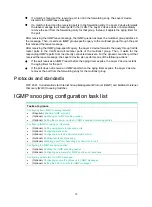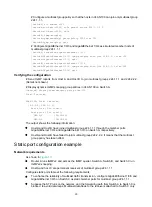
19
Step Command
Remarks
dynamic member ports in the
VLAN.
interval
seconds.
Configuring static ports
You can configure the following types of static ports:
•
Static member port
—When you configure a port as a static member port for a multicast group,
all hosts attached to the port will receive multicast data for the group.
The static member port does not respond to IGMP queries. When you complete or cancel this
configuration on a port, the port does not send an unsolicited IGMP report or leave message.
•
Static router port
—When you configure a port as a static router port for a multicast group, all
multicast data for the group received on the port will be forwarded.
Static member ports and static router ports never age out. To remove such a port, use the
undo
igmp-snooping static-group
or
undo igmp-snooping static-router-port
command.
To configure static ports:
Step Command
Remarks
1.
Enter system view.
system-view
N/A
2.
Enter Layer 2 Ethernet
interface view or Layer 2
aggregate interface view.
interface interface-type
interface-number
N/A
3.
Configure the port as a static
port.
•
Configure the port as a static
member port:
igmp-snooping
static-group
group-address
[
source-ip source-address
]
vlan
vlan-id
•
Configure the port as a static
router port:
igmp-snooping
static-router-port
vlan
vlan-id
By default, a port is not a static
member port or a static router
port.
Configuring a port as a simulated member host
When a port is configured as a simulated member host, it is equivalent to an independent host in the
following ways:
•
It sends an unsolicited IGMP report when you complete the configuration.
•
It responds to IGMP general queries with IGMP reports.
•
It sends an IGMP leave message when you cancel the configuration.
The version of IGMP running on the simulated member host is the same as the version of IGMP
snooping running on the port. The port ages out in the same way as a dynamic member port.
To configure a port as a simulated member host:
Step Command
Remarks
1.
Enter system view.
system-view
N/A
2.
Enter Layer 2 Ethernet
interface interface-type
N/A






























